Creating a stunning flowers garden isn’t just about throwing seeds in the ground and hoping for the best. It’s about understanding the intricate dance between soil, sunlight, water, and plant biology to create a living masterpiece that evolves throughout the seasons. Whether you’re starting with a blank canvas of bare earth or revitalizing an existing space, the path to a truly breathtaking flowers garden requires both scientific knowledge and artistic vision.
The difference between a mediocre garden and one that stops passersby in their tracks lies in the details—understanding how different plants interact with their environment, knowing when and how to intervene, and creating sustainable systems that support both plant health and ecological balance. This comprehensive guide brings together decades of horticultural wisdom, cutting-edge sustainable practices, and time-tested techniques that transform ordinary outdoor spaces into extraordinary sanctuaries.
From soil preparation that sets the foundation for vibrant blooms to advanced techniques for season-long color, these expert strategies will help you cultivate not just beautiful flowers, but a thriving ecosystem that supports local wildlife while minimizing environmental impact. Let’s dig into the essential knowledge that will transform your gardening approach and create the flowers garden of your dreams.
1. Test Your Soil to Unlock Hidden Growing Potential
Understanding your soil’s unique characteristics is the cornerstone of any successful flowers garden. A comprehensive soil test reveals pH levels, nutrient availability, and organic matter content—critical factors that determine whether your plants will merely survive or truly thrive. This scientific foundation eliminates the guesswork that leads to disappointing results and wasted resources.
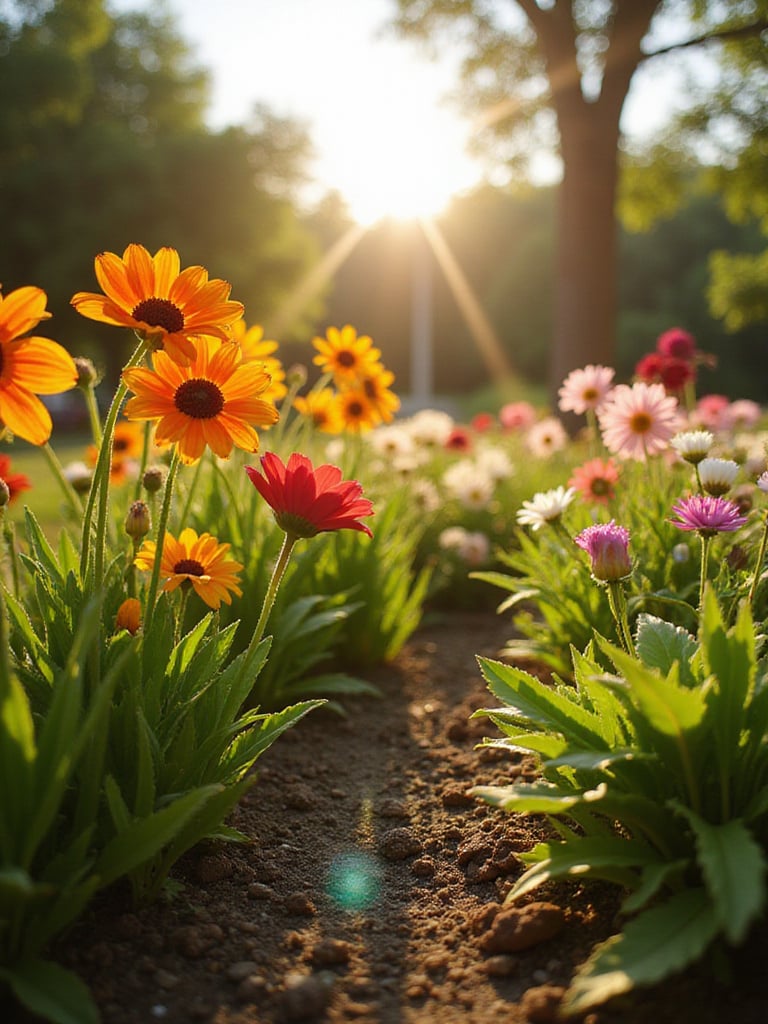
Professional soil testing provides precise data about nitrogen, phosphorus, and potassium levels, along with essential micronutrients like iron and magnesium. Most flowers garden enthusiasts are surprised to discover that their soil pH—often overlooked—can lock up nutrients even when they’re present in adequate quantities. For instance, alkaline soils above 7.5 can prevent iron uptake, leading to yellowing leaves despite healthy root systems.
Key soil testing benefits:
- Reveals specific nutrient deficiencies before they impact plant health
- Identifies pH imbalances that affect nutrient availability
- Determines organic matter levels for improved soil structure
- Provides baseline data for tracking improvement over time
The investment in professional testing typically pays for itself within the first growing season through reduced fertilizer costs and improved plant performance. Many university extension offices offer comprehensive testing for under $25, providing detailed recommendations tailored to your specific region and intended plantings.
Beyond the numbers, soil testing reveals the living ecosystem beneath your feet, where billions of microorganisms work to break down organic matter and make nutrients available to plant roots.
2. Choose Climate-Appropriate Plants for Effortless Beauty
Selecting plants that naturally thrive in your specific climate zone dramatically reduces maintenance while maximizing bloom production and longevity. This approach works with nature rather than against it, creating a flowers garden that flourishes with minimal intervention while supporting local ecosystems and wildlife populations.

Native and adapted plants have evolved over thousands of years to handle your region’s temperature extremes, rainfall patterns, and soil conditions. These plants typically require 50% less water than non-native alternatives and show greater resistance to local pests and diseases. Additionally, they provide crucial habitat and food sources for native pollinators, creating a self-sustaining garden ecosystem.
Climate-smart plant selection criteria:
- USDA hardiness zone compatibility for winter survival
- Heat tolerance ratings for summer performance
- Drought resistance levels matching local rainfall
- Native pollinator relationships for ecosystem support
Research your local growing conditions thoroughly, including average frost dates, summer heat patterns, and typical precipitation. Many gardeners focus solely on cold hardiness while overlooking heat tolerance, leading to plant stress during summer months. Plants struggling against climate extremes redirect energy from flower production to survival, resulting in sparse, lackluster blooms.
The artisans’ commitment to environmental practices means selecting regionally appropriate species that have proven their resilience over generations of cultivation.
3. Design Strategic Plant Placement for Maximum Visual Impact
Thoughtful placement transforms individual plants into a cohesive flowers garden that guides the eye and creates dramatic focal points throughout the growing season. This involves understanding how different heights, textures, and bloom times work together to create depth and sustained interest rather than random splashes of color.

The classic “thriller, filler, spiller” principle applies beyond containers to entire garden beds. Tall architectural plants like delphiniums or sunflowers serve as anchors, medium-height plants like coneflowers provide substance, while low-growing varieties like sweet alyssum create flowing edges. Color temperature also plays a crucial role—warm colors (reds, oranges, yellows) appear to advance toward viewers, while cool colors (blues, purples, whites) recede, creating illusions of depth and space.
Essential design elements:
- Vertical layering from ground covers to tall specimens
- Color progression from cool to warm or monochromatic schemes
- Seasonal succession ensuring continuous bloom periods
- Focal points drawing attention to key garden areas
Consider sight lines from windows, patios, and pathways when positioning your most spectacular specimens. Plants viewed from multiple angles need all-around appeal, while those seen primarily from one direction can be designed for maximum impact from that perspective. Repetition of key plants or color themes throughout the space creates unity and prevents the scattered appearance common in beginning gardens.
What makes this design special is the way each element supports and enhances its neighbors, creating compositions that evolve beautifully as plants mature and seasons change.
4. Master Deep Watering Techniques for Drought-Resistant Plants
Deep, infrequent watering develops robust root systems that can access moisture and nutrients from lower soil layers, creating naturally drought-resistant plants that require less frequent irrigation. This technique mimics natural rainfall patterns and encourages roots to grow downward rather than spreading superficially near the surface.

Most flowers garden failures stem from frequent shallow watering that keeps roots concentrated in the top few inches of soil. When surface moisture evaporates during hot weather, these shallow-rooted plants quickly experience stress. Deep watering involves applying water slowly until it penetrates 8-12 inches into the soil, then allowing the surface to dry before the next irrigation cycle.
Deep watering best practices:
- Apply 1-2 inches of water per session rather than daily sprinkles
- Water early morning to minimize evaporation losses
- Use soaker hoses or drip irrigation for efficient delivery
- Check soil moisture at root depth before watering again
Soil type significantly affects watering frequency and duration. Sandy soils drain quickly and may need water every 3-4 days, while clay soils can go 7-10 days between deep waterings. Mulching around plants reduces surface evaporation by up to 70%, extending the time between watering sessions while maintaining consistent soil moisture.
The sustainable journey of this material involves understanding that water conservation and plant health work hand in hand to create resilient garden ecosystems.
5. Time Your Planting for Optimal Establishment Success
Strategic timing of planting activities can increase establishment success rates by 40-60% while reducing transplant shock and long-term maintenance requirements. Understanding seasonal growth patterns and weather cycles allows you to work with natural rhythms rather than fighting against them.

Spring planting works best for warm-season annuals and most perennials, allowing full growing seasons for root development before winter stress. However, fall planting often proves superior for trees, shrubs, and cool-season flowers, as cooler temperatures reduce water stress while soil remains warm enough for root growth. Many experienced gardeners have discovered that fall-planted perennials often outperform spring-planted specimens in their second year.
Optimal planting windows:
- Cool-season annuals: 4-6 weeks before last frost
- Warm-season annuals: 2-3 weeks after last frost
- Perennials: Spring after soil workable or fall 6-8 weeks before hard frost
- Bulbs: Fall when soil temperature drops below 60°F
Weather patterns immediately following planting significantly impact establishment success. Avoid planting during heat waves or extended dry periods when even consistent watering may not prevent stress. Cloud cover and gentle rain during the first week after transplanting provide ideal conditions for root development.
The unexpected environmental benefit comes from timing plantings to coincide with natural growth cycles, reducing the need for supplemental inputs while maximizing plant performance.
6. Create Nutrient-Rich Soil Through Composting Systems
Building your own compost system transforms kitchen scraps and yard waste into premium soil amendment while reducing household waste by up to 30%. This closed-loop approach creates the rich, living soil that serves as the foundation for any exceptional flowers garden while eliminating the need for synthetic fertilizers.

Effective composting requires balancing carbon-rich “brown” materials like dried leaves and paper with nitrogen-rich “green” materials such as vegetable scraps and grass clippings. The ideal ratio is approximately 3:1 browns to greens by volume. Proper moisture levels—comparable to a wrung-out sponge—and regular turning ensure aerobic decomposition that produces sweet-smelling, nutrient-rich compost in 3-6 months.
Essential composting components:
- Carbon sources: dried leaves, paper, cardboard, wood chips
- Nitrogen sources: vegetable scraps, coffee grounds, fresh grass clippings
- Moisture management through regular monitoring and adjustment
- Aeration via turning or passive air circulation systems
Finished compost improves soil structure in both clay and sandy soils while providing slow-release nutrients and beneficial microorganisms. Unlike synthetic fertilizers that provide quick nutrient bursts followed by depletion, compost creates sustained fertility that supports plant health throughout the growing season.
The traditional methods used result in soil amendment that costs a fraction of commercial alternatives while providing superior long-term benefits for plant health and soil ecology.
7. Implement Integrated Pest Management for Chemical-Free Gardens
Integrated Pest Management (IPM) creates balanced ecosystems where beneficial insects naturally control harmful pests, eliminating the need for synthetic pesticides while protecting pollinators and soil health. This approach focuses on prevention, monitoring, and targeted intervention using biological and cultural controls.

Understanding pest life cycles and natural predator relationships allows gardeners to time interventions for maximum effectiveness with minimal environmental impact. For example, releasing ladybugs during early aphid infestations can prevent population explosions that would otherwise require more intensive management. Companion planting with herbs like basil and marigolds provides natural pest deterrence while attracting beneficial insects.
IPM strategy components:
- Regular monitoring to identify problems before they escalate
- Cultural controls like proper spacing and sanitation
- Biological controls using beneficial insects and natural predators
- Physical barriers and traps for specific pest problems
Many pest issues stem from plant stress caused by improper growing conditions rather than external infestations. Healthy plants growing in optimal conditions show natural resistance to most common garden pests. When intervention becomes necessary, targeted organic treatments like insecticidal soap or neem oil address specific problems without disrupting beneficial insect populations.
The environmental story behind this piece began with recognizing that healthy garden ecosystems can largely manage themselves when provided with proper conditions and biodiversity.
8. Extend Growing Seasons with Succession Planting Techniques
Succession planting involves staggering plantings of the same varieties at 2-3 week intervals to ensure continuous harvests and blooms throughout the growing season. This technique prevents the feast-or-famine cycles common in flowers garden where everything blooms simultaneously then fades together.
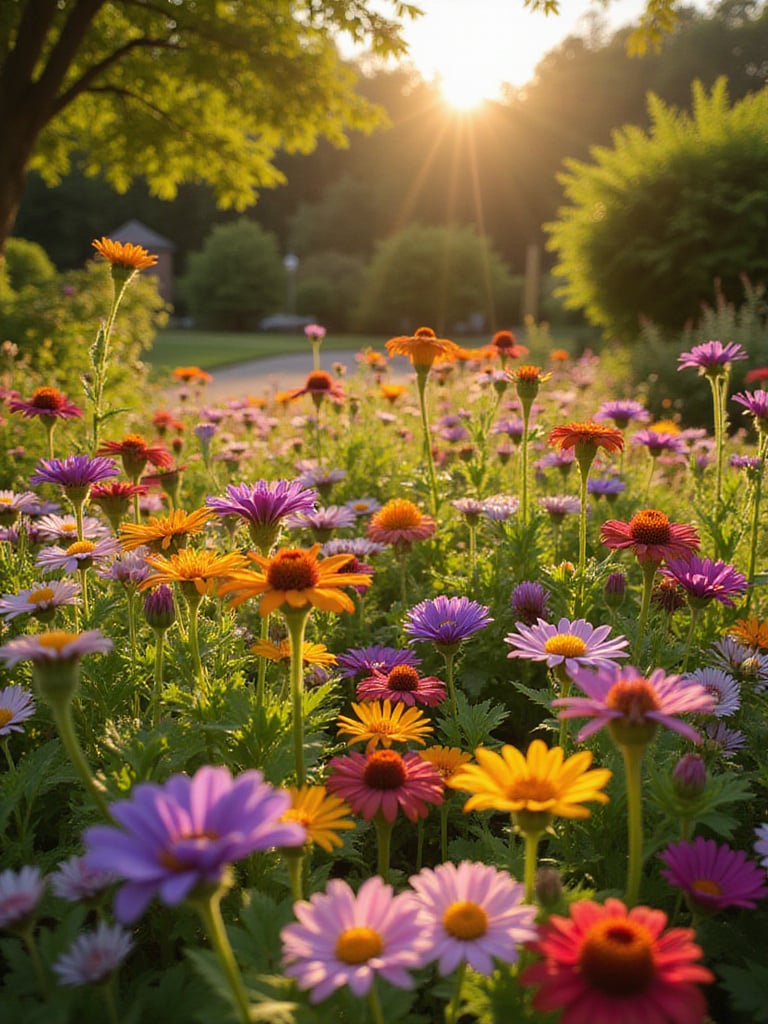
Cool-season flowers like snapdragons and sweet peas can be planted multiple times from early spring through fall in many climates, providing color during periods when heat-sensitive varieties struggle. Similarly, warm-season annuals benefit from multiple plantings that extend their display period and provide backup plants when early plantings decline during peak summer heat.
Succession planting strategies:
- Stagger plantings every 2-3 weeks for continuous bloom
- Use different varieties with varying maturity dates
- Plan fall plantings for extended autumn color
- Maintain backup plants for mid-season replacements
This approach requires advance planning and record-keeping to track planting dates and varieties, but the results justify the effort through extended garden performance. Many gardeners discover that late-season plantings often outperform early ones as they avoid peak pest pressure and benefit from improved growing conditions.
The revival of this classic form comes with a twist of modern understanding about plant biology and seasonal growing patterns that maximize both beauty and sustainability.
9. Establish Efficient Irrigation Systems for Water Conservation
Modern irrigation technology allows precise water delivery that can reduce consumption by 30-50% while improving plant health through consistent moisture levels. Drip irrigation and soaker hose systems deliver water directly to root zones, minimizing evaporation and preventing foliar diseases associated with overhead watering.
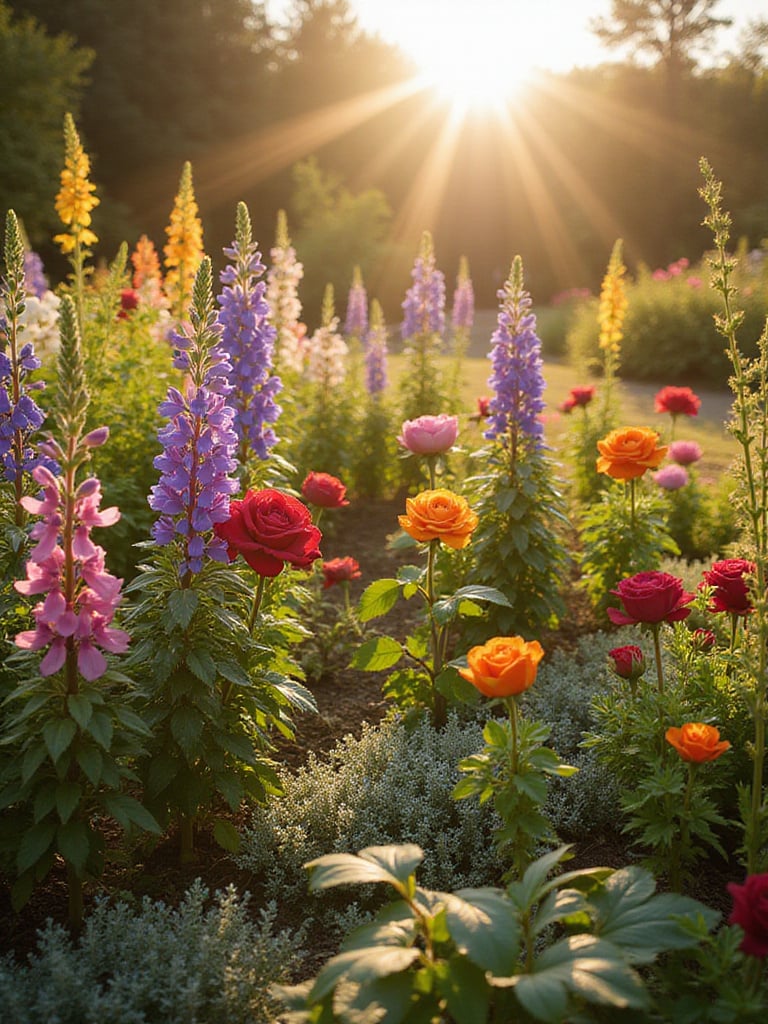
Smart irrigation controllers that adjust watering schedules based on weather data and soil moisture sensors eliminate the guesswork that leads to overwatering or drought stress. These systems can integrate with local weather stations to skip irrigation cycles during rainy periods and adjust timing based on temperature and humidity levels.
Water-efficient irrigation features:
- Zone-based watering for different plant water requirements
- Moisture sensors that prevent unnecessary watering
- Weather-based scheduling adjustments
- Low-pressure emitters for gentle, thorough soil penetration
Proper system design considers plant spacing, soil type, and slope to ensure uniform water distribution. Grouping plants with similar water needs into irrigation zones allows for customized watering schedules that meet each plant’s requirements without waste. Mulching around plants helps retain irrigation water while reducing surface evaporation.
The forecast for next season already hints at increasing water restrictions in many regions, making efficient irrigation systems essential for sustainable flowers garden management.
10. Select Disease-Resistant Varieties for Low-Maintenance Gardens
Choosing disease-resistant plant varieties eliminates many common flowers garden problems before they start, reducing the need for fungicide treatments while ensuring reliable performance throughout the growing season. Modern breeding programs have developed cultivars with genetic resistance to prevalent diseases like powdery mildew, black spot, and bacterial wilt.

Disease resistance varies significantly among cultivars of the same species. For example, while traditional bee balm (Monarda) suffers from severe powdery mildew in humid conditions, resistant varieties like ‘Jacob Cline’ and ‘Marshall’s Delight’ maintain healthy foliage all season. Similarly, newer zinnia varieties show remarkable resistance to powdery mildew that plagued older cultivars.
Disease-resistant selection criteria:
- Research common diseases in your region
- Choose varieties with proven resistance records
- Prioritize newer cultivars with improved genetics
- Consider regional adaptation and local breeding programs
University extension services often maintain trial gardens that evaluate disease resistance under local conditions. These resources provide valuable information about which varieties perform best in specific regions and climate conditions. Many seed companies now clearly label disease resistance characteristics, making selection easier for home gardeners.
The unexpected pairing that always works is combining disease-resistant varieties with proper cultural practices like adequate spacing and good air circulation to create nearly maintenance-free gardens.
11. Practice Crop Rotation Principles in Ornamental Gardens
Applying crop rotation principles to flowers garden prevents soil-borne disease buildup and nutrient depletion while maintaining soil health and plant vigor. This agricultural technique, adapted for ornamental use, involves changing plant families in specific garden areas on a 3-4 year cycle.
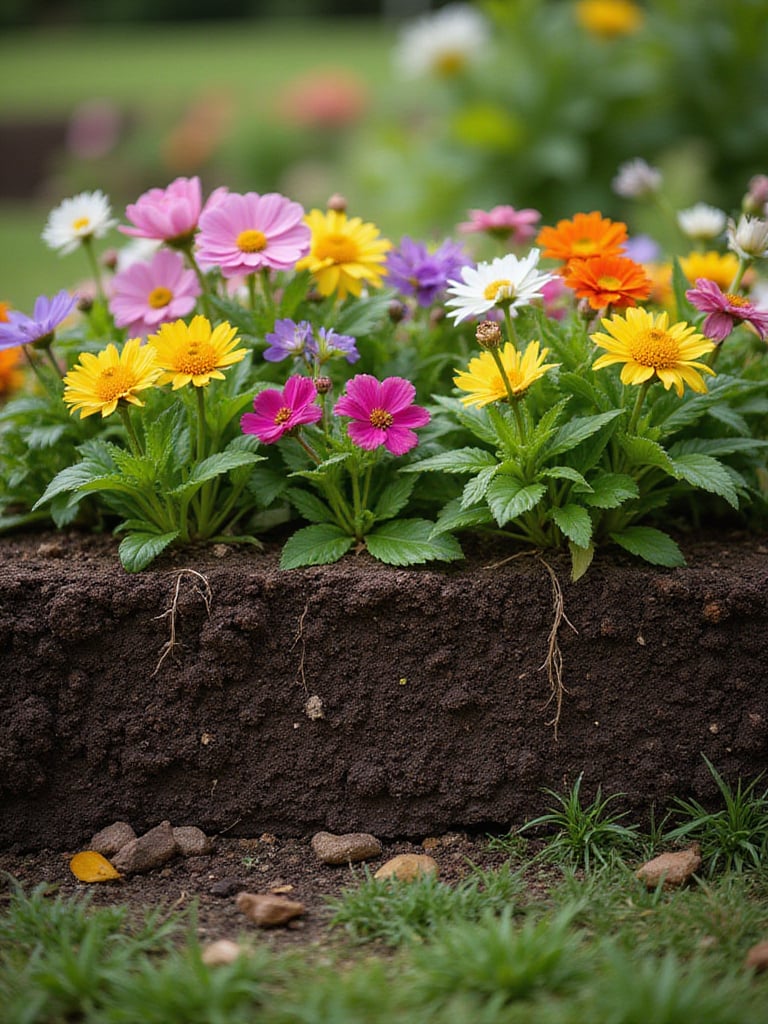
Different plant families have varying nutrient requirements and susceptibility to specific diseases and pests. Rotating between plant families breaks disease cycles and prevents the soil exhaustion that occurs when the same plants grow in identical locations year after year. For example, following heavy-feeding annuals like sunflowers with nitrogen-fixing legumes like sweet peas improves soil fertility naturally.
Rotation planning considerations:
- Group plants by botanical families rather than appearance
- Track planting locations with garden maps or photos
- Plan 3-4 year rotation cycles for maximum benefit
- Include soil-improving plants like legumes in rotation
This practice proves especially valuable for annual flowers garden where the same varieties might otherwise occupy identical locations each year. Perennial gardens benefit from rotating annual plantings used to fill gaps and provide seasonal color. Record-keeping becomes essential for tracking which plant families have grown in specific areas.
The composition comes together when you realize that this ancient agricultural wisdom applies perfectly to modern ornamental gardening challenges.
12. Optimize Soil pH for Maximum Nutrient Availability
Soil pH dramatically affects nutrient availability even when adequate nutrients exist in the soil. Most flowering plants perform best in slightly acidic to neutral soil (pH 6.0-7.0), where essential nutrients remain readily available for plant uptake. Outside this range, nutrients become chemically bound and unavailable despite their physical presence.

Understanding pH management allows gardeners to unlock existing soil nutrients rather than continuously adding fertilizers that plants cannot access. For example, iron deficiency symptoms often indicate alkaline soil conditions rather than actual iron shortage. Lowering soil pH through organic matter addition or sulfur application can resolve these issues without iron supplementation.
pH management strategies:
- Test soil pH annually using reliable methods
- Adjust gradually using organic amendments
- Monitor plant response to pH modifications
- Consider plant-specific pH requirements
Organic matter addition provides the most sustainable approach to pH management, as decomposing materials naturally buffer soil pH toward optimal ranges. Sulfur applications lower pH in alkaline soils, while lime raises pH in acidic conditions. These adjustments require patience, as significant changes may take 6-12 months to fully develop.
The finishing touch that elevates the entire look involves understanding that proper pH creates the foundation for all other garden management practices to succeed.
13. Encourage Beneficial Insects Through Habitat Creation
Creating diverse habitat attracts beneficial insects that provide natural pest control, pollination services, and ecosystem balance in flowers garden settings. This involves providing food sources, nesting sites, and overwintering habitat for insects that support garden health throughout the growing season.
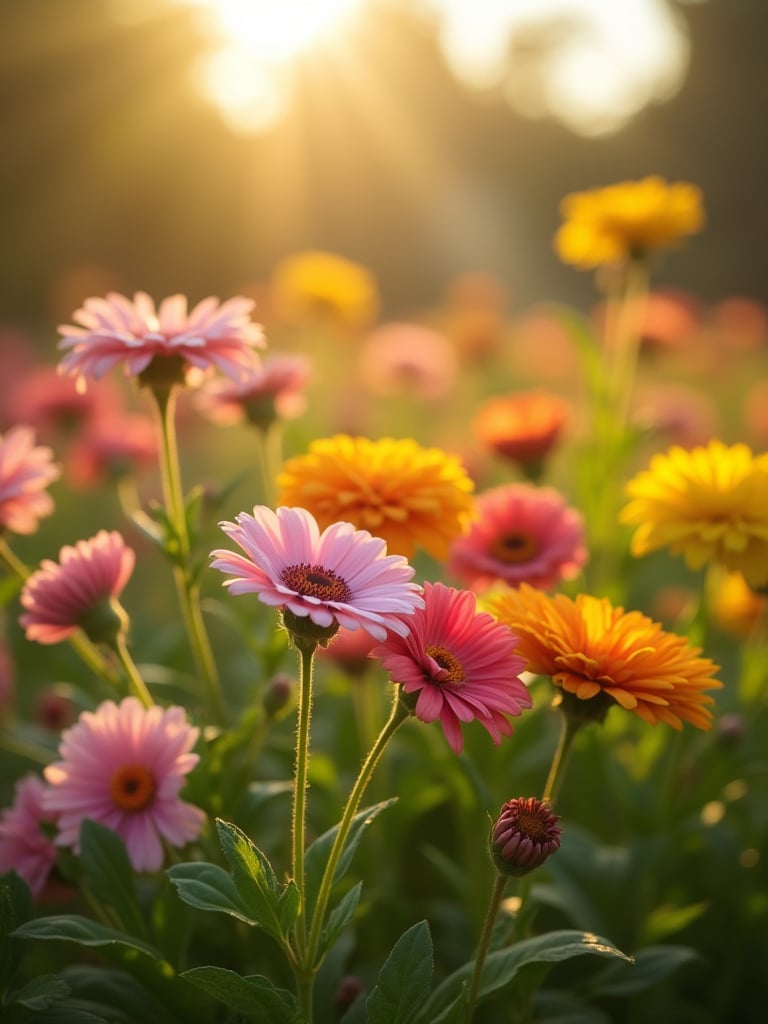
Beneficial insects require different resources at various life stages. Adult predatory insects often need nectar sources, while their larvae require specific host plants or prey species. Providing diverse flowering plants that bloom throughout the season ensures consistent food sources, while leaving some garden areas undisturbed provides nesting and overwintering sites.
Beneficial insect habitat elements:
- Diverse flowering plants for nectar and pollen sources
- Native plants that support specialized insect relationships
- Undisturbed areas for nesting and overwintering
- Water sources for drinking and reproduction
Small-flowered plants like sweet alyssum and dill provide easily accessible nectar for tiny beneficial insects, while larger flowers serve bigger species. Avoiding pesticide use, even organic ones, during peak beneficial insect activity protects these valuable garden allies. Many beneficial insects are most active during early morning and evening hours when targeted treatments can minimize impact.
The visual weight balances perfectly when beneficial insect populations reach levels where they naturally control pest problems without human intervention.
14. Implement Season Extension Techniques for Year-Round Interest
Season extension techniques allow flowers garden to provide interest and even active growth well beyond traditional growing seasons. This involves using protective structures, microclimates, and strategic plant selection to extend both spring and fall growing periods while providing winter interest through structural elements.

Cold frames, row covers, and simple hoop tunnels can extend growing seasons by 4-8 weeks on both ends while protecting plants from wind and temperature extremes. These structures create beneficial microclimates that allow tender plants to survive light frosts and continue growing during marginal weather conditions.
Season extension methods:
- Protective structures for frost and wind protection
- Microclimate creation using thermal mass and shelter
- Strategic plant placement for maximum protection
- Winter interest plants for year-round appeal
Thermal mass elements like stone walls or water features moderate temperature swings and provide protection for nearby plants. South-facing locations protected from north winds often remain several degrees warmer than exposed areas, allowing extended growing periods for marginally hardy plants.
The ambiance evolves throughout the day as natural light changes, revealing different aspects of season extension techniques and their impact on garden performance.
15. Practice Sustainable Fertilization Through Organic Methods
Organic fertilization builds long-term soil health while providing balanced nutrition that supports sustained plant growth and bloom production. This approach feeds soil organisms that, in turn, make nutrients available to plants in forms they can readily absorb and utilize throughout the growing season.

Synthetic fertilizers provide immediate nutrient availability but often lack the micronutrients and organic matter that support comprehensive plant health. Organic fertilizers release nutrients slowly as soil organisms break them down, providing sustained nutrition that matches plant growth patterns while improving soil structure and water retention.
Organic fertilization principles:
- Feed soil organisms rather than plants directly
- Use diverse organic matter sources for complete nutrition
- Time applications to match plant growth cycles
- Monitor plant response and adjust accordingly
Compost, aged manure, and organic fertilizer blends provide balanced nutrition while supporting beneficial soil microorganisms. These materials improve soil structure, increase water retention, and provide slow-release nutrition that reduces the risk of nutrient burn or leaching that can occur with synthetic fertilizers.
The investment value comes from the exceptional long-term soil improvement that reduces future fertilization needs while supporting increasingly productive gardens.
16. Design for Pollinators with Native Plant Communities
Creating native plant communities that support local pollinator populations throughout their life cycles provides essential habitat while ensuring reliable garden performance with minimal maintenance. This approach recognizes that pollinators need more than just nectar sources—they require host plants for reproduction and diverse habitat for different life stages.
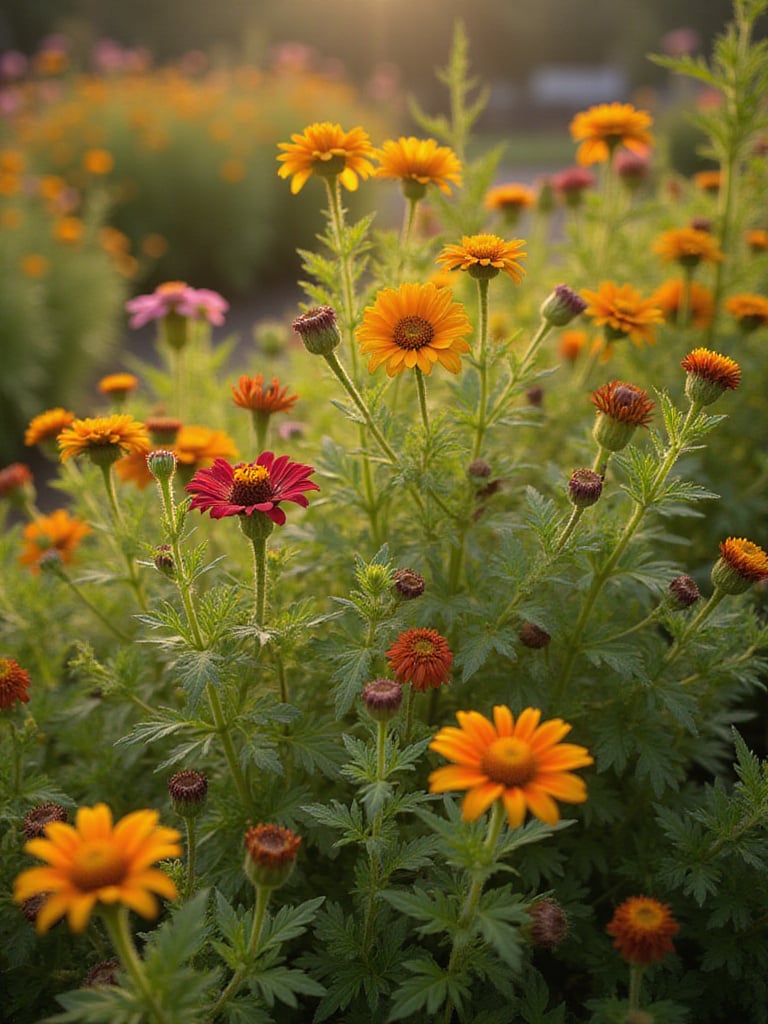
Native plant communities have co-evolved with local pollinator species over thousands of years, creating specialized relationships that support biodiversity while providing reliable garden performance. These plants typically require less water, fertilizer, and pest management than non-native alternatives while providing superior wildlife habitat.
Native pollinator garden elements:
- Host plants for butterfly and moth larvae
- Diverse bloom times for season-long nectar sources
- Nesting sites for native bees and beneficial insects
- Overwintering habitat for pollinator life cycles
Regional native plant societies and extension services provide excellent resources for identifying appropriate native species and understanding their ecological relationships. Many areas have specialized native plant nurseries that offer locally adapted varieties and expert advice for successful establishment.
The cultural heritage preserved in each piece includes thousands of years of co-evolution between plants and pollinators that creates self-sustaining garden ecosystems.
17. Manage Garden Microclimates for Optimal Plant Performance
Understanding and managing microclimates within your flowers garden allows you to grow plants that might otherwise struggle in your general climate zone while optimizing performance of all garden plants. Microclimates are small areas with conditions that differ from the surrounding environment due to factors like topography, structures, and thermal mass.

South-facing walls create warm microclimates that can extend growing zones by 1-2 zones, while low-lying areas may be several degrees cooler and more prone to frost. Wind exposure, drainage patterns, and sun exposure all contribute to microclimate variations that can be managed through strategic design and plant placement.
Microclimate management techniques:
- Use thermal mass to moderate temperature swings
- Create windbreaks for protection from drying winds
- Improve drainage in low-lying areas
- Maximize sun exposure for heat-loving plants
Observing your garden throughout different seasons reveals microclimate patterns that can be enhanced or modified through landscape design. Adding thermal mass like stone features or water elements can moderate temperature extremes, while strategic plantings can create windbreaks or channel cooling breezes.
The emotional response this evokes begins with recognizing that every garden contains multiple growing environments that can be optimized for different plant communities.
18. Establish Proper Garden Maintenance Schedules
Consistent maintenance schedules prevent small problems from becoming major issues while ensuring optimal plant performance throughout the growing season. This involves creating seasonal task lists that address plant needs at appropriate times while maintaining garden health and appearance.

Preventive maintenance proves far more effective and less time-consuming than reactive problem-solving. Regular deadheading, weeding, and monitoring allow gardeners to address issues when they’re easily manageable rather than waiting until problems become severe and require intensive intervention.
Essential maintenance schedule components:
- Weekly monitoring and minor maintenance tasks
- Monthly major maintenance like pruning and fertilizing
- Seasonal preparation and cleanup activities
- Annual planning and evaluation sessions
Keeping maintenance records helps identify patterns and optimize timing for various garden tasks. Many gardeners find that spending 15-20 minutes daily on garden maintenance prevents the need for marathon weekend sessions while maintaining better garden health and appearance.
The styling mistake most people make is attempting to address all maintenance needs in intensive weekend sessions rather than spreading tasks throughout the week for better results.
19. Plan for Four-Season Garden Interest
Four-season garden design ensures that your flowers garden provides visual interest throughout the year rather than looking barren during non-blooming periods. This involves selecting plants with attractive bark, seed heads, evergreen foliage, and winter structure alongside traditional flowering plants.

Winter interest becomes especially important in climates with extended dormant seasons. Plants with attractive bark, persistent seed heads, or evergreen foliage provide structure and visual appeal when herbaceous plants have died back. Ornamental grasses offer excellent winter interest while providing habitat for beneficial insects and birds.
Four-season interest elements:
- Evergreen plants for winter structure and color
- Plants with attractive bark or winter silhouettes
- Seed heads and dried flowers for winter texture
- Early spring bloomers for extended growing seasons
Strategic placement of four-season plants creates focal points that remain attractive year-round while providing structure for seasonal plantings. These permanent elements serve as the backbone around which seasonal displays can be designed and modified over time.
The heritage technique gets a contemporary update through modern understanding of how four-season design principles create gardens that remain engaging throughout the year.
20. Incorporate Sustainable Water Management Practices
Sustainable water management reduces environmental impact while creating more resilient flowers garden that can withstand drought conditions and water restrictions. This involves capturing and storing rainwater, improving soil water retention, and selecting plants that thrive with minimal irrigation.

Rain gardens and bioswales capture stormwater runoff while providing attractive planting areas for moisture-loving plants. These features reduce erosion, filter pollutants, and create unique growing environments that support different plant communities than traditional garden beds.
Sustainable water management strategies:
- Rainwater collection and storage systems
- Soil improvement for increased water retention
- Drought-tolerant plant selection and placement
- Efficient irrigation system design and management
Permeable paving materials and strategic grading direct water toward planted areas rather than allowing it to run off into storm drains. These techniques reduce water waste while providing irrigation for garden plants during dry periods.
The maker’s journey from apprentice to master influenced the development of water management techniques that work with natural systems rather than against them.
21. Practice Integrated Garden Design for Ecosystem Health
Integrated garden design considers the flowers garden as part of a larger ecosystem that includes soil organisms, beneficial insects, birds, and other wildlife. This holistic approach creates self-sustaining systems that require minimal external inputs while providing maximum environmental benefits.

Understanding ecological relationships allows gardeners to design plant communities that support each other through nitrogen fixation, pest control, and soil improvement. These polyculture systems prove more resilient and productive than monoculture plantings while providing diverse habitat for wildlife.
Integrated design principles:
- Plant communities that support ecological relationships
- Habitat creation for beneficial wildlife
- Soil health improvement through diverse plantings
- Natural pest and disease management systems
Observing natural plant communities provides inspiration for garden designs that work with ecological principles rather than requiring constant intervention. These systems become more productive and attractive over time as ecological relationships develop and strengthen.
The evolution of this trend reflects broader cultural shifts toward understanding gardens as part of larger environmental systems rather than isolated decorative elements.
22. Develop Long-Term Garden Sustainability Plans
Long-term sustainability planning ensures that your flowers garden continues to thrive and improve over time while reducing resource inputs and environmental impact. This involves selecting plants and practices that build soil health, support biodiversity, and create resilient garden ecosystems.

Sustainable gardens become more productive and attractive over time as soil health improves and ecological relationships develop. This contrasts with high-input gardens that require increasing amounts of fertilizer, water, and pest control to maintain their appearance and productivity.
Sustainability planning elements:
- Soil health improvement through organic matter addition
- Plant selection for long-term performance and adaptation
- Resource conservation through efficient design and management
- Ecosystem development for natural balance and resilience
Long-term planning considers how garden elements will mature and change over time, allowing for plant growth and succession while maintaining design integrity. This forward-thinking approach prevents many common garden problems while creating increasingly valuable landscape assets.
When you run your hand across the finished grain, you’re touching not just beautiful plants, but a small piece of landscape being actively regenerated with each growing season.
Conclusion
Creating a breathtaking flowers garden represents far more than arranging beautiful plants—it’s about understanding and working with natural systems to create sustainable, thriving ecosystems that provide beauty while supporting environmental health. These 22 expert tips provide the foundation for developing gardens that become more productive, attractive, and ecologically valuable over time.
The journey from novice to expert gardener involves continuous learning and adaptation as you observe how different techniques work in your specific conditions. Each growing season offers new opportunities to refine your approach, experiment with different plants and methods, and develop the deep understanding that separates truly exceptional gardens from merely adequate ones.
Your flowers garden has the potential to become a model of sustainable beauty that inspires others while providing habitat for wildlife, improving soil and water quality, and creating a legacy of environmental stewardship. Start with the techniques that resonate most strongly with your current situation and gradually incorporate additional strategies as your knowledge and confidence grow. The investment in learning these sustainable practices will reward you with increasingly spectacular results while contributing to broader environmental health and resilience.










